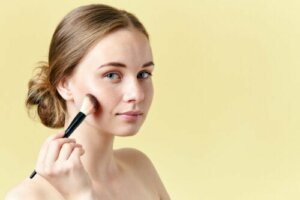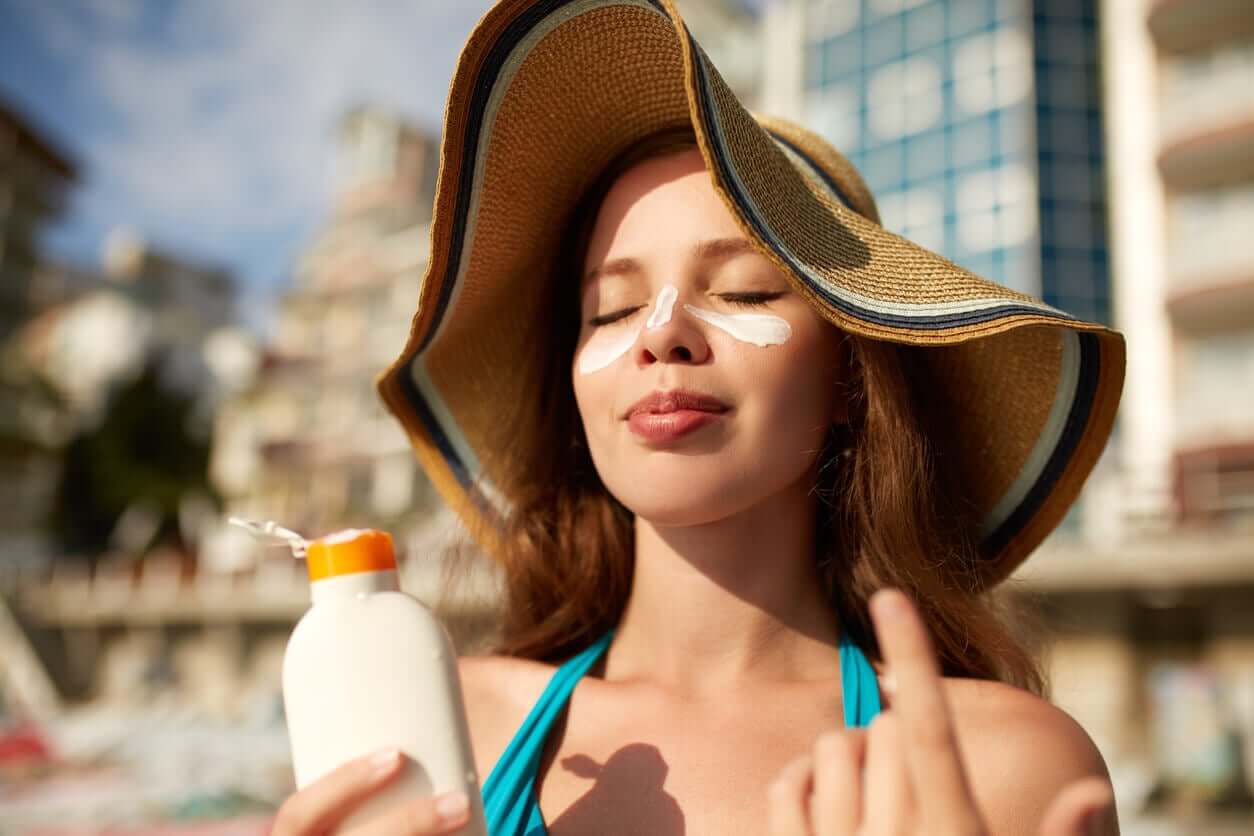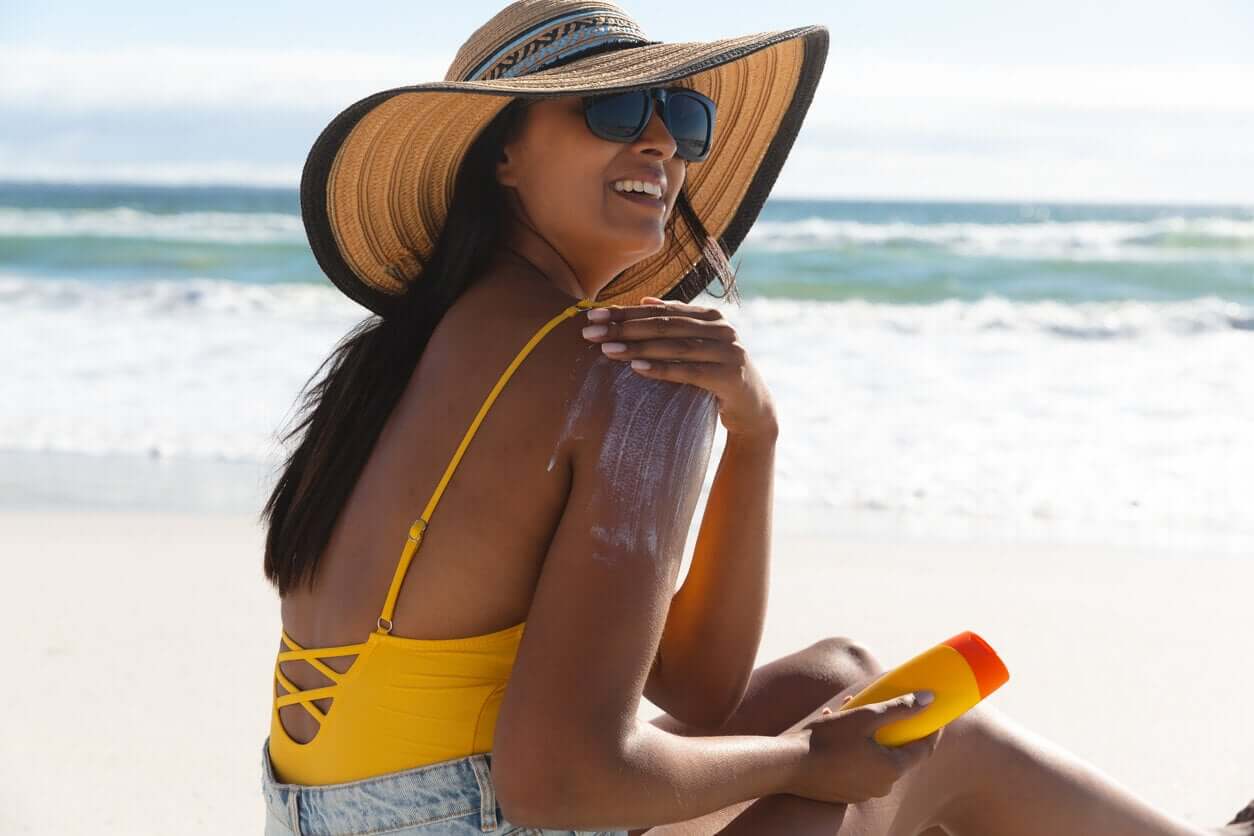The Risks of Contouring with Sunscreen

Contouring is a makeup technique that uses a light and shadow effect to highlight and hide different parts of the face. The dangerous thing is when you stop using makeup powders to achieve this look and instead, you proceed to the selective use of sunscreen on the face. This phenomenon has been promoted a lot from social networks, as some influencers openly recommend it. Today, we want to tell you about the risks of contouring with sunscreen.
What is contouring?
As we’ve mentioned, this is the name given to a facial makeup technique that aims to highlight certain features of the facial structure. That is, to enhance the most beautiful details and hide those that are imperfect or less harmonious.
This technique isn’t new. In fact, it’s been used for centuries by theatrical actors. With it, it’s possible to outline the face and refine the jaw, nose, forehead, etc.
Contouring with illuminating and concealing makeup is acceptable given the fact that it’s temporary. With facewash or a little micellar water, it’s easily removed.
However, when it comes to contouring with sunscreen, using selective exposure to UV rays, things change. The damage suffered by the skin of the face by tanning isn’t temporary or reversible, and it also increases the risks of suffering injuries in the future.
Contouring with sunscreen
This form of contouring is a trend in social networks and was promoted as a viral challenge among adolescents.
The technique is based on using natural tanning for specific areas that you want to darken, thanks to the non-application of sunscreen on these areas. At the same time, the areas that you want to illuminate should be covered with protection.
Specifically, high-sunscreen creams are placed on the upper cheekbones, nasal septum, chin, eyebrows, eye contour, and mouth area. The rest of the skin on the face is exposed to sunlight in order to darken.
There are other healthier methods that suggest the use of sunscreen with high filters (SPF 50 or more) in the mentioned areas and one of less protection for everywhere else.

Read also: The Best Sunscreens for Babies and Children
How was this viral trend created?
Although the intellectual author of this technique is believed to be Beyoncé’s makeup artist, the truth is that this practice reached its greatest popularity with the publications of Eli Withrow, through her TikTok account.
Either way, they both promote using a high-filter sunscreen all over the face and then outlining facial details and features with a lower-filter sunscreen.
The video posted by Withrow managed to garner more than 13 million views in the span of one year. The diffusion of this challenge caused it to be misinterpreted, and many young people choose to only apply sunscreen to certain areas of the face, leaving other areas unprotected.
There’s another variant of this technique of contouring with sunscreen that enhances the abs based on the same concept. Sunscreen is applied to the regions that you want to illuminate (those with more volume) and the deeper areas are tanned.
The risks of contouring with sunscreen
The videos of well-known influencers have gone viral, with millions of views around the world. This encourages your followers to copy them and recreate these effects.
However, these practices aren’t recommended because they can cause severe skin and health consequences, such as the following:
- Skin burns
- The appearance of liver spots or sunspots
- Premature aging and predisposition to wrinkles
- Loss of elasticity of the skin
- An increased risk of skin cancer
As a dermatologist, my recommendation is not to attempt the practice of contouring with sunscreen, but rather use the conventional method using makeup.
You may be interested: 10 Natural Remedies for Sunburn
WHO recommendations
The World Health Organization highlights the negative consequences of unprotected sun exposure. Among them are cataracts, sunburns, skin carcinomas, or malignant cutaneous melanoma.
At the same time, they suggest some simple measures to enjoy the sun in a responsible and healthy way:
- Protect yourself with hats and caps from the sun
- Reduce sun exposure from 10 am to 3 pm
- Wear clothing with sunscreen
- Know the day’s UV index
- Use sunscreen every day
- Opt for the shade, whenever possible
Tanning is nothing more than the skin manifesting the damage caused by ultraviolet rays.

Contouring with sunscreen isn’t recommended
The skin has a memory, and everything we do to it during our youth will have long-term effects. Sun damage is cumulative and malignant manifestations can be seen several years later.
Therefore, you need to avoid this dangerous trend that exposes the skin surface to certain easily avoidable dangers. Sunscreen should always be placed on all skin exposed to the sun’s rays and without any exception.
Contouring is a makeup technique that uses a light and shadow effect to highlight and hide different parts of the face. The dangerous thing is when you stop using makeup powders to achieve this look and instead, you proceed to the selective use of sunscreen on the face. This phenomenon has been promoted a lot from social networks, as some influencers openly recommend it. Today, we want to tell you about the risks of contouring with sunscreen.
What is contouring?
As we’ve mentioned, this is the name given to a facial makeup technique that aims to highlight certain features of the facial structure. That is, to enhance the most beautiful details and hide those that are imperfect or less harmonious.
This technique isn’t new. In fact, it’s been used for centuries by theatrical actors. With it, it’s possible to outline the face and refine the jaw, nose, forehead, etc.
Contouring with illuminating and concealing makeup is acceptable given the fact that it’s temporary. With facewash or a little micellar water, it’s easily removed.
However, when it comes to contouring with sunscreen, using selective exposure to UV rays, things change. The damage suffered by the skin of the face by tanning isn’t temporary or reversible, and it also increases the risks of suffering injuries in the future.
Contouring with sunscreen
This form of contouring is a trend in social networks and was promoted as a viral challenge among adolescents.
The technique is based on using natural tanning for specific areas that you want to darken, thanks to the non-application of sunscreen on these areas. At the same time, the areas that you want to illuminate should be covered with protection.
Specifically, high-sunscreen creams are placed on the upper cheekbones, nasal septum, chin, eyebrows, eye contour, and mouth area. The rest of the skin on the face is exposed to sunlight in order to darken.
There are other healthier methods that suggest the use of sunscreen with high filters (SPF 50 or more) in the mentioned areas and one of less protection for everywhere else.

Read also: The Best Sunscreens for Babies and Children
How was this viral trend created?
Although the intellectual author of this technique is believed to be Beyoncé’s makeup artist, the truth is that this practice reached its greatest popularity with the publications of Eli Withrow, through her TikTok account.
Either way, they both promote using a high-filter sunscreen all over the face and then outlining facial details and features with a lower-filter sunscreen.
The video posted by Withrow managed to garner more than 13 million views in the span of one year. The diffusion of this challenge caused it to be misinterpreted, and many young people choose to only apply sunscreen to certain areas of the face, leaving other areas unprotected.
There’s another variant of this technique of contouring with sunscreen that enhances the abs based on the same concept. Sunscreen is applied to the regions that you want to illuminate (those with more volume) and the deeper areas are tanned.
The risks of contouring with sunscreen
The videos of well-known influencers have gone viral, with millions of views around the world. This encourages your followers to copy them and recreate these effects.
However, these practices aren’t recommended because they can cause severe skin and health consequences, such as the following:
- Skin burns
- The appearance of liver spots or sunspots
- Premature aging and predisposition to wrinkles
- Loss of elasticity of the skin
- An increased risk of skin cancer
As a dermatologist, my recommendation is not to attempt the practice of contouring with sunscreen, but rather use the conventional method using makeup.
You may be interested: 10 Natural Remedies for Sunburn
WHO recommendations
The World Health Organization highlights the negative consequences of unprotected sun exposure. Among them are cataracts, sunburns, skin carcinomas, or malignant cutaneous melanoma.
At the same time, they suggest some simple measures to enjoy the sun in a responsible and healthy way:
- Protect yourself with hats and caps from the sun
- Reduce sun exposure from 10 am to 3 pm
- Wear clothing with sunscreen
- Know the day’s UV index
- Use sunscreen every day
- Opt for the shade, whenever possible
Tanning is nothing more than the skin manifesting the damage caused by ultraviolet rays.

Contouring with sunscreen isn’t recommended
The skin has a memory, and everything we do to it during our youth will have long-term effects. Sun damage is cumulative and malignant manifestations can be seen several years later.
Therefore, you need to avoid this dangerous trend that exposes the skin surface to certain easily avoidable dangers. Sunscreen should always be placed on all skin exposed to the sun’s rays and without any exception.
All cited sources were thoroughly reviewed by our team to ensure their quality, reliability, currency, and validity. The bibliography of this article was considered reliable and of academic or scientific accuracy.
- Calzavara-Pinton P, Ortel B, Venturini M. Non-melanoma skin cancer, sun exposure and sun protection. G Ital Dermatol Venereol. 2015 Aug;150(4):369-78. Epub 2015 Jul 17. PMID: 26186380.
- Kennedy C, Bajdik CD, Willemze R, De Gruijl FR, Bouwes Bavinck JN; Leiden Skin Cancer Study. The influence of painful sunburns and lifetime sun exposure on the risk of actinic keratoses, seborrheic warts, melanocytic nevi, atypical nevi, and skin cancer. J Invest Dermatol. 2003 Jun;120(6):1087-93. doi: 10.1046/j.1523-1747.2003.12246.x. PMID: 12787139.
- Moan J, Grigalavicius M, Baturaite Z, Dahlback A, Juzeniene A. The relationship between UV exposure and incidence of skin cancer. Photodermatol Photoimmunol Photomed. 2015 Jan;31(1):26-35. doi: 10.1111/phpp.12139. Epub 2014 Oct 13. PMID: 25213656.
This text is provided for informational purposes only and does not replace consultation with a professional. If in doubt, consult your specialist.








